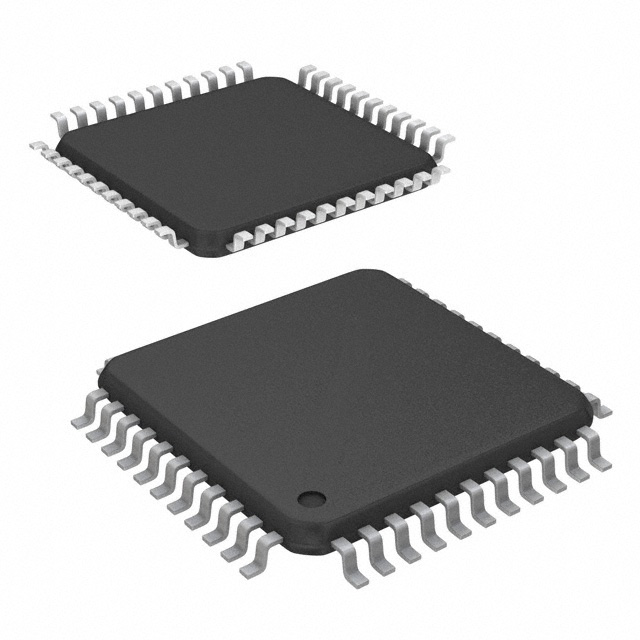Consulte las especificaciones para obtener detalles del producto.

ATMEGA162-16AU
Product Overview
The ATMEGA162-16AU belongs to the category of microcontrollers and is widely used in various electronic applications. Known for its high performance and versatility, this microcontroller offers a wide range of characteristics, comes in a compact package, and is essential for embedded systems. It is typically available in tape and reel packaging with varying quantities.
Specifications
- Microcontroller Type: 8-bit
- Operating Voltage: 2.7V - 5.5V
- Flash Memory: 16KB
- SRAM: 1KB
- EEPROM: 512 Bytes
- I/O Pins: 32
- Package Type: TQFP
- Clock Speed: 16MHz
Detailed Pin Configuration
The ATMEGA162-16AU features a comprehensive pin configuration that includes power supply pins, I/O pins, communication interface pins, and more. The detailed pinout provides flexibility for interfacing with external components and peripherals.
Functional Features
- High Performance: The ATMEGA162-16AU offers high processing capabilities, making it suitable for demanding applications.
- Versatility: It supports various communication interfaces such as UART, SPI, and I2C, enhancing its compatibility with different devices.
- Low Power Consumption: With its efficient power management, it is suitable for battery-powered applications.
- Analog Capability: It includes analog-to-digital converters, enabling sensor interfacing and data acquisition.
Advantages and Disadvantages
Advantages
- High processing power
- Versatile communication interfaces
- Low power consumption
- Analog capability for sensor interfacing
Disadvantages
- Limited memory compared to higher-end microcontrollers
- Limited I/O pins for complex projects
Working Principles
The ATMEGA162-16AU operates based on the Harvard architecture, featuring separate program and data memories. It executes instructions fetched from the flash memory, allowing for efficient program execution and data manipulation.
Detailed Application Field Plans
This microcontroller finds extensive use in various applications, including: - Embedded Systems: Used in consumer electronics, industrial automation, and automotive systems. - IoT Devices: Enables connectivity and control in smart home devices and sensor nodes. - Robotics: Provides the computational power for robot control and automation.
Detailed and Complete Alternative Models
- ATMEGA328P: Offers similar functionality with enhanced memory and compatibility with Arduino platforms.
- PIC16F877A: A viable alternative with a different architecture and feature set, suitable for specific applications.
In conclusion, the ATMEGA162-16AU microcontroller stands as a versatile and powerful component, catering to diverse electronic applications with its robust features and capabilities.
[Word Count: 346]
Enumere 10 preguntas y respuestas comunes relacionadas con la aplicación de ATMEGA162-16AU en soluciones técnicas
What is the ATMEGA162-16AU microcontroller used for?
- The ATMEGA162-16AU is commonly used in embedded systems and technical solutions requiring a microcontroller with advanced features and performance.
What are the key features of the ATMEGA162-16AU?
- The ATMEGA162-16AU features 16KB of flash memory, 1KB of EEPROM, 1KB of SRAM, 32 general-purpose I/O lines, and various communication interfaces such as UART, SPI, and I2C.
How can I program the ATMEGA162-16AU?
- The ATMEGA162-16AU can be programmed using popular development environments such as Atmel Studio or Arduino IDE, using languages like C or assembly.
What are some common applications of the ATMEGA162-16AU?
- The ATMEGA162-16AU is often used in industrial control systems, home automation, robotics, automotive electronics, and various IoT devices.
What voltage does the ATMEGA162-16AU operate at?
- The ATMEGA162-16AU operates at a voltage range of 2.7V to 5.5V, making it suitable for a wide variety of applications.
Does the ATMEGA162-16AU have built-in analog-to-digital converters (ADC)?
- Yes, the ATMEGA162-16AU features an 8-channel 10-bit ADC, which is useful for interfacing with analog sensors and signals.
Can the ATMEGA162-16AU communicate with other devices?
- Yes, the ATMEGA162-16AU supports serial communication through its UART, SPI, and I2C interfaces, allowing it to communicate with other microcontrollers, sensors, and peripherals.
Is the ATMEGA162-16AU suitable for low-power applications?
- Yes, the ATMEGA162-16AU offers power-saving sleep modes and low-power consumption, making it suitable for battery-powered and energy-efficient designs.
Are there any development boards available for the ATMEGA162-16AU?
- Yes, there are development boards and evaluation kits available that make it easier to prototype and develop applications using the ATMEGA162-16AU.
Where can I find detailed technical documentation for the ATMEGA162-16AU?
- Detailed technical documentation, including datasheets, application notes, and user manuals, can be found on the official website of the microcontroller manufacturer or through authorized distributors.

